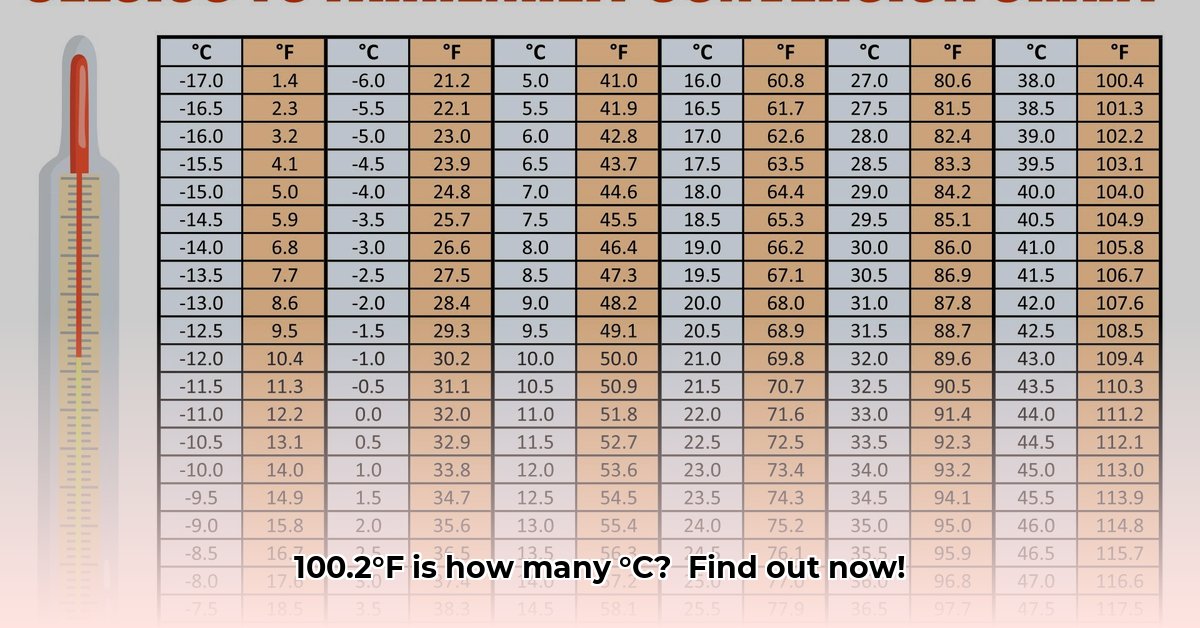37.89°C
Conversion Details
The formula to convert Fahrenheit to Celsius is: °C = (5/9) * (°F – 32). Here’s how it applies to 100.2°F:
- Subtract 32: 100.2°F – 32 = 68.2
- Multiply by 5/9: 68.2 * (5/9) = 37.888…
- Round: 37.89°C
Interactive Calculator
(Insert interactive calculator here) A user-friendly calculator allows for quick conversions of any Fahrenheit temperature to Celsius.
Understanding Fahrenheit and Celsius
Fahrenheit
Daniel Gabriel Fahrenheit devised the Fahrenheit scale in the early 18th century. His scale used a mixture of ice, water, and ammonium chloride for 0°F and likely approximated human body temperature for 96°F (though potentially miscalculated). The Fahrenheit scale became common, especially in the United States.
Celsius
Later in the 18th century, Anders Celsius developed the Celsius scale (also known as centigrade), setting the freezing point of water at 0°C and the boiling point at 100°C. This straightforward approach contributed to its widespread adoption internationally.
Conversion Table
| Fahrenheit (°F) | Celsius (°C) |
|---|---|
| 99.5 | 37.50 |
| 99.8 | 37.67 |
| 100.0 | 37.78 |
| 100.2 | 37.89 |
| 100.5 | 38.06 |
Real-World Context
A body temperature of 100.2°F (37.89°C) likely suggests a low-grade fever. While not typically alarming in isolation, it may indicate the body is fighting off an illness. Consult a doctor if the fever persists or if other symptoms appear.
Other Temperature Scales
Kelvin
The Kelvin scale is an absolute temperature scale where 0 K represents absolute zero, the theoretically lowest possible temperature. It’s frequently used in scientific contexts.
Rankine
Rankine is another absolute temperature scale, related to Fahrenheit in the same way Kelvin is related to Celsius.
Frequently Asked Questions
Why is Celsius used more widely?
Celsius’s direct link to the freezing and boiling points of water likely contributes to its greater international use. This simple and intuitive system makes it convenient for scientific and everyday use.
How accurate is this conversion?
Rounding to two decimal places is typically sufficient for everyday use. In scientific settings requiring higher precision, additional significant figures may be necessary. Ongoing research in metrology may refine temperature measurement standards further.
Why is 37°C considered “normal” body temperature?
The generally accepted range for normal human body temperature is 36.5°C to 37.5°C (97.7°F to 99.5°F), with some individual variation considered normal. Slight deviations within this range are common and not usually a cause for concern.
What causes a 100.2°F (37.9°C) fever?
Numerous factors can cause a low-grade fever, including common colds, the flu, minor infections, stress, or even certain medications. A fever is a symptom, not a disease itself, indicating the body’s response to an underlying condition.
What should I do if I have a 100.2°F (37.9°C) fever?
Stay hydrated, rest, and consider over-the-counter medications like acetaminophen or ibuprofen to reduce discomfort. If the fever persists, worsens, or is accompanied by other symptoms like a severe headache or difficulty breathing, consult a medical professional. For infants and young children, consult a pediatrician for even slightly elevated temperatures, as their thermoregulation differs from adults. Ongoing research continues to explore the complexities of fever in children.
- Where to Buy Bento Boxes for Healthy, Organized Meals - December 9, 2025
- Plastic Bento Boxes Make Meal Prep and Cleanup Effortless - December 8, 2025
- Shop Bento Lunch Boxes on Sale Nearby Now - December 7, 2025










